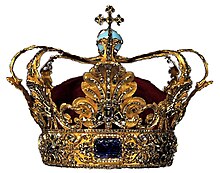Absolute crown

The Absolute Crown (also Crown of Christian V ) has been the official crown of the Kingdom of Denmark since 1671 . She was by King Friedrich III. commissioned for his son Christian V after the absolute hereditary monarchy was successfully introduced in 1660 .
Although the absolute crown was worn on the occasion of a coronation , it was never used for the ritual act of coronation itself. Because since the royal dignity was now transferred by inheritance law, - d. H. without the participation of the nobility or the imperial estates (see choice of king ), - the coronation was limited to the religious rite of anointing . The anointing was abolished with the end of absolutism (constitution of 1849 ). Since then, the crown has only been used to lay out a deceased monarch on the Castrum doloris .
The Absolute Crown is located with the other Danish crown jewels in the treasury of Rosenborg Castle in Copenhagen .
layout
The crown was made by Paul Kurtz in 1670/71. It consists of gold , enamel and cut gemstones . The crown is 21 cm high and about 25 cm in diameter with a total weight of 2080 grams. The coronet bears four large gemstones. On the front and back two sapphires of 84 and 144 carats and on the sides a ruby of 90 and a spinel of 107 carats. In the spaces between the stones, the coronet bears a tendril ornament made of diamonds, which, starting from a star in the center, ends in S-shaped volutes in diamond blossoms. Eight tines in the shape of a broad leaf are attached to the hoop above the hoop and are connected to one another above the hoop by volute-shaped ends of the leaves. These leaf prongs are adorned with a ray-shaped ornament that arises from large diamonds or diamond rosettes in the middle of the leaf. They are strongly curved outwards. The temples, which are shaped like narrow leaves and covered with diamonds, are attached to their tips. The stirrups bend in volute shape above the leaf ends and slightly dent towards the apex, where they carry the globe and cross. The blue enameled globe has bands of diamonds on the equator line and radially from front to back and at right angles to it on the top. The cross is made of diamonds and has the shape of clover leaves at the ends.
literature
- Heinz Biehn : The crowns of Europe and their fate . Limes Verlag, Wiesbaden 1957.
